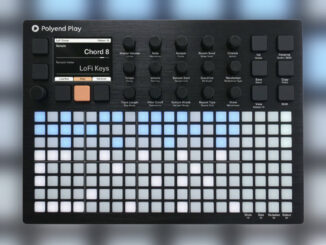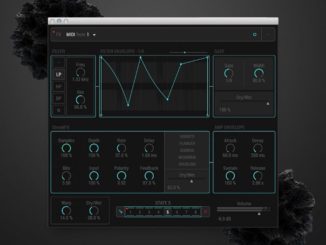Ableton Move is out now and is a new battery-powered hardware sketchbook/groovebox for ideas on the go with onboard sampling and more.
Previously, you could only sample into Ableton Move via the external audio input. That’s changing now. Ableton has just released firmware 1.3 that brings sampling via USB-C to its sketchbook/groovebox. This allows you to sample the audio from a connected computer, smartphone, or tablet.
For example, you can now use an iPad Synthesizer and sample new sounds into the Move. That’s a big new feature for the Move hardware.
Alongside many bug fixes, the new firmware 1.3 also includes more improvements.
- You can now solo tracks by pressing and holding the Shift and Mute buttons simultaneously and then pressing a track button.
- Longer entries in the browser, such as sample or preset names, now scroll on the display so that the full name is visible.
- When used as an audio interface, Move now defaults to outputting its internal microphone and line-in. Move’s main output can still be selected in Setup; however, doing so will disable Move’s speaker when a USB-C cable is connected.
Another major new feature is the introduction of polyphonic aftertouch output. Move now sends out polyAT when set to MIDI Out, which lets you play expressively when using external MIDI controllers. That’s a very welcome new feature for it.
I am pleased to see that the Move is growing increasingly in terms of functions. I hope it will continue like this in the future.
Update 1.2 From December 10, 2024
Just before the end of the year, Ableton has released another update for its standalone groovebox. The new Move 1.2 firmware update now ships with MIDI sync (i.e., MIDI clock) out when Move is set to receive MIDI notes.
This allows USB MIDI devices with internal sequencers and arpeggiators, such as Arturia Beatstep Pro, AKAI MPK Series, or Novation Launchkey series, to be synced to Move’s clock, while allowing Move to be played from the device at the same time.
For USB MIDI devices capable of passing MIDI signals through, such as AKAI MPK Series, additional external gear can also be synced to Move’s clock. Such setups allow Move to act as the central clock source while retaining playability from the connected USB MIDI device.
Further, it comes with other minor improvements, and bug fixes.
Update 1.1.2 From October 8, 2024
The first big update for the Ableton Move sketchbook/groovebox is out now. The new update 1.1.2 adds a new 16 pitches layout that allows you to play drum samples melodically using the 16 pads to the right of the Drum Rack pads.
Then, there is a new arpeggiator mode for the melodic instruments. You can now turn a chord into a sequence of individual notes with Arpeggiator. You can explore three different arpeggiator styles: Arp Up, Arp Down, or Arp Random
Plus, you can now use the Ableton Move as a control surface for Ableton Live. In this, you can launch clips and scenes in Move’s session mode in this mode. Good to see the new further development.
Article From October 8, 2024
The pictures of Ableton Move leaked over the weekend are accurate. This is what the new Ableton Move looks like.
Today, Ableton officially presented the instrument with all the information we needed.
Ableton Move Hardware
Move is a new standalone hardware from the Berlin company. It’s not a Push 3 light, even if it looks like the flagship has been split into two. Maybe a Baby Push?
The hardware, powered by a modern ARM processor, consists of 32 velocity-sensitive polyphonic aftertouch pads, nine high-resolution encoders, a touch-sensitive, clickable jog wheel, and 16 backlit multifunctional buttons.
On the back, you get a power on/off button, a headphone/stereo line output, a stereo line input for sampling, a USB host for MIDI devices, and a USB-C port for data, audio, and power. A built-in battery powers the unit for up to 4 hours of continuous play, or you can power it via USB-C.
It’s a very light and portable device with just 0,97kg and dimensions of W313.5 x D146.3 x H34mm.
Where Push 3 standalone gives you almost all the power and options of Ableton Live and Max For Live, Move takes a sketchy approach with fewer features but more focus on creativity than total production.
Move is not a feature-rich groovebox but rather a music sketchbook hardware for the on-the-go, with which you can make tracks and later finalize them in Ableton Live. What Ableton Note is on iOS, now as hardware.
Four Tracks
It offers four tracks with selectable instruments: drum, melodic, or sampler. These are based on the popular Ableton Live devices, including the drum sampler, wavetable synth, Drift synth, and melodic sampler.
However, the instruments are not available in their full version in the hardware. Like in Ableton Note, you get a simplified version with macro controls. We may have to wait and see how this develops in the future. Maybe we get more parameters in future updates.
Each comes with a big collection of sounds that can be easily tweaked on the hardware. The sampler is more versatile here.
You can sample into the Ableton Move hardware using the built-in microphone, the stereo line input or USB-C audio to feed the sampler with custom sounds. Plus, you can use it to re-sample your tracks in the hardware. The built-in 64GB memory offers plenty of space for sampling.
The engine also has various effect processors to mangle or refine your sounds, including reverb, delay, saturator, chorus-ensemble, phaser-flanger, redux, channel EQ, and compressor.
Creative Features
Sounds can be recorded in the built-in sequencer using the pads or the 16 hardware buttons underneath the 32 pads. For additional creativity, it also comes with best-known features from Ableton Live, including the unique capture feature that remembers what you just played.
It also includes a repeat function designed to generate repeated notes quickly. Plus, you get parameter automation for the parameters.
Then, the session mode is your creative hub, where your notes and beats become a track. You can mix and combine your musical ideas by triggering the clips with Move’s aftertouch pads. Once finished, you can export your tracks as a Move file into Ableton Live or as an MP3.
Control Live
In addition to a groovebox, I was speculating on a new MIDI controller. It’s a standalone hardware sketchbook, but the latter can do it, too. You can turn the hardware into a MIDI controller for Ableton Live using Live Control mode.
You can use the Ableton Move hardware controls and pads to program sequences, launch clips, and tweak parameters.
Other Features
Ableton Move also offers built-in WiFi with Ableton Link support, which makes it easy to sync with other hardware in your setup. WiFi also supports file exchange, so you can easily export your tracks to Ableton Live, Note, or Push.
Another nice feature: the USB-C port also works as an audio interface. Once connected to your computer or mobile device, you can route the hardware audio via USB out of the device.
Ableton Move First Impression
At first glance, it’s an intruiging portable hardware. As I said, it’s not a full-fledged groovebox, but for me, it’s more of a music sketchbook hardware with which you can capture music ideas that you can complete later.
Even though I’m an intensive Ableton Live user, it wouldn’t be hardware that would appeal to me right now. I prefer Ableton Note for on-the-go. For people who prefer dedicated hardware with controls, this could be ideal.
Ableton Move is available now for $449/449€
More information here: Ableton
Available at my partner









It’s a miracle – my gear-acquisition ailment has suddenly lifted. I’m cured!
I have the same problem. 😉
Hallelujah! They’ve cured us 😂
a midi out port would have been nice, especially at this price point.
I’m just going to say it.
Boring and superfluous.
😡
Dear All
I am writing to express my deep dissatisfaction with the new groovebox I recently launched. Unfortunately, it has proven to be a subpar product, especially considering it is marketed as a four-channel drum machine sampler. It is disappointing to find that it cannot even compete with basic iPhone apps in terms of functionality KK and performance.
In comparison to other portable drum machine samplers, this product falls embarrassingly short. It seems that companies today prioritize profit over quality, disregarding the needs and expectations of their customers. This particular device appears to be running on a Raspberry Pi-type engine with a very basic operating system. Furthermore, I was surprised to find that it lacks a dedicated slot for an SD card, which is a fundamental feature for any sampler.
I fear that this product will quickly become obsolete and end up in the gear graveyard within the next six months. In a time when we have access to advanced AI music technology, affordable electronics, and high-quality 4K mobile video, it is disheartening that such a poorly designed product has been released.
I believe that companies should consider open-sourcing their products, similar to what has been done with the Deluge synth. Even smaller companies like Polyend have managed to create superior sampler grooveboxes, which makes this situation even more frustrating.
I urge fellow musicians and producers to critically evaluate these products and not fall for the marketing hype. We deserve better than being misled by companies that prioritize profits over quality. It’s time to speak out and demand transparency and accountability in the gear we purchase.
Thank you for your attention to this matter.
Sincerely, DIGGIY
?
I love the idea of a sketchbook very very much, so I’ll start with… Ableton Note.
Move has a accessibility option for blind users using screenreaders, using its internal local server thingie:
https://www.youtube.com/watch?v=p8IbinbOhY4
Iam quite happy with my decision to grab the Move. Instant idea sketch pad with fluent workflow and perfect synchronised with Live. The newest updates are worth fully. I wish just threshold and synched loop sampling while playing. Don’t believe the haters!